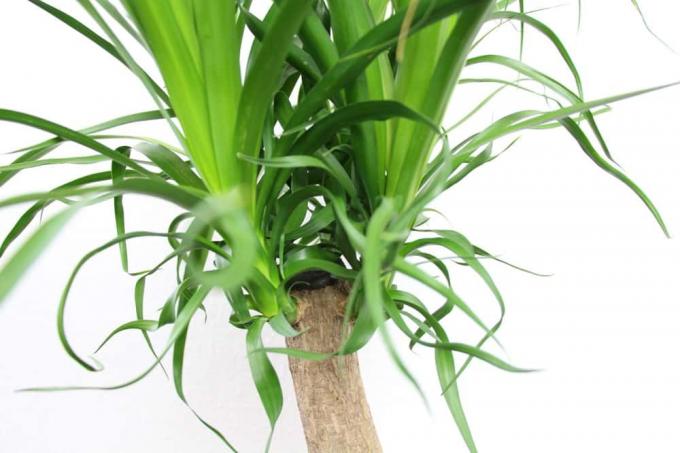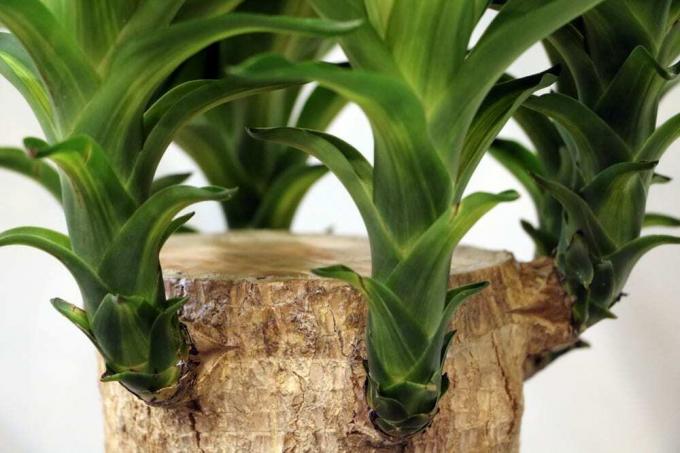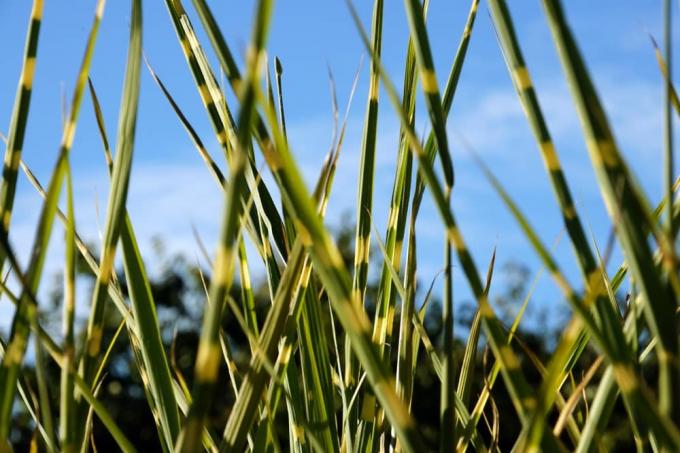

Table of contents
- time
- material requirements
- Instructions for pruning
- Repot rejuvenated yucca
- Clippings are used for propagation
- Plant stem cuttings across
- Yuccas rejuvenate by mossing
- Conclusion
- Worth knowing about cutting the yucca shortly
As they get older, yucca palms sometimes lose their shapely shape. They hit the ceiling, threaten to tip over, form thin trunks with puny tufts of leaves due to the lack of light and spread a sad mood. High time for a makeover that goes hand in hand with a bold pruning. How to properly cut back yucca palms should no longer remain hidden from you here. The following practical guide for hobby gardeners shows how to perfectly rejuvenate yucca.
time
Although pruning a yucca palm is possible throughout the year, the weeks from the end of March to mid-May are considered to be a particularly good time. In this phase, the yucca are not yet fully sap, so that the inevitable cuts do not bleed too much. Cutting back the agave plants during the winter dormancy has the disadvantage that the chances of a possible propagation of the stem pieces are then close to zero.
material requirements
In addition to choosing the ideal date for the rejuvenation of yucca, the quality of the tools and working materials have a decisive influence on the successful course of the Measure. If you want to properly prune yucca palms, you should be equipped with these accessories:
- a sturdy jigsaw
- alternatively a sharp bread knife
- a small knife with a smooth cutting surface
- Work gloves to protect against the sharp blade edges
- several pots with bottom opening for water drainage
- Palm soil or potting soil, sand and perlite
- crushed potsherds, pebbles or grit
- Tree wax or similar wound sealant
Although yuccas are incorrectly referred to as palm trees, their trunks show a similar firmness as real palm trees with advanced age. The cutting tool should therefore be freshly sharpened so that the cuts do not fray unnecessarily. Careful disinfection is also advantageous in order to prevent any possibility of attack by lurking fungal spores and bacteria.
Instructions for pruning
Once all the materials are ready, the work can begin. It is perfectly normal for an inexperienced home gardener to be plagued by reservations. In that case, consider the actual botanical nature of a yucca again. The trunks only visually resemble a real palm tree trunk. While palm trees usually have a single growing point near the crown, woody yuccas have numerous dormant eyes just below the bark. If you prune yucca trees properly using these instructions, plants will sprout from these dormant nodes in a short time.
- Cut back the trunk to the desired height in 20-30 cm long segments.
- Straighten the interfaces with the smooth knife.
- Immediately mark the polarity on each section if an increase is planned.
- Treat any cuts with tree wax or wound sealant.
- Alternatively, seal with charcoal ash.

It is advisable not to completely seal the cuts with tree wax. It has been found that it is entirely sufficient if the wound edges are coated with the preparation. In this case, no moisture can accumulate under the seal, which in the worst case can lead to rot.
Repot rejuvenated yucca
When you prune yucca palms, you put extreme stress on the plants. The chances of rapid regeneration are better if you transplant the rejuvenated trunk base with the root ball into fresh substrate. Here's how to do it:
- the previous bucket can be reused
- alternatively choose a new pot that is only slightly larger
- create a drainage over the bottom opening made of potsherds, pebbles or grit
- Spread an air- and water-permeable fleece over it so that the drainage does not become blocked
- fill the planter halfway with a mix of substrate and sand or perlite
- Insert the potted palm lily in the middle, fill the cavities with potting soil and water
If the root ball is exposed, experienced hobby gardeners take a close look at it. Root strands that appear unhealthy are cut out on this occasion. If the bale is heavily compacted, score it 0.5 cm deep in two or three places with a cutter knife. Alternatively, loosen up the root area with both hands.
Clippings are used for propagation
After pruning yucca palms, you have a lot of suitable material for breeding more specimens. For this purpose, experienced hobby gardeners mark the growth direction on the trunk segments during the regeneration. If the polarity is wrong during propagation, the entire project is doomed to fail. How to properly treat the stem pieces:
- Fill the available pots with drainage and a mixture of palm soil and sand.
- Alternatively, use lean, well-drained potting soil.
- Plant half of a stem segment in each planter, taking into account the previous direction of growth.
- Water the substrate to cover the pot with a plastic bag.
Placed in a warm, bright location, the stem cuttings will sprout from the dormant eyes within a few weeks. As soon as the first shoots appear, the cover is removed. A dose of diluted liquid fertilizer has a beneficial effect on the further process of rooting. The plants must be kept constantly moist throughout the entire period without causing waterlogging. When the young shoots have developed into new leaflets, repot the plants into substrate for adult yucca palms.
Tip:
The lower rows of leaves are removed from leafy stem cuttings and placed in a container with water for rooting. The addition of a piece of charcoal reduces the risk of rot.
Plant stem cuttings across
If you failed to mark the direction of growth when pruning, you do not have to put the propagation ad acta by a long shot. In this case, cut the stem segments so that they fit across a nursery pot. Plant the cuttings there so that they are not completely covered with substrate. New shoots also sprout vertically from the knots below the bark in the warm, bright place.
Yuccas rejuvenate by mossing
A variant for the rejuvenation of yucca palms, works according to the mossing method. To do this, choose the height to which the yucca should be cut back. At this point, loosen a piece of the bark and cut the trunk diagonally with a sharp, disinfected knife. Then take a plastic pot, cut it open and enlarge the drainage hole so that you can place it over the stem of the yucca. The planter is fixed with padded wires so that it can then be filled with potting soil. During the following days and weeks the substrate is kept slightly moist. Initially, delicate roots form from the incisions, which over time form a dense network. This is the signal to cut the yucca stem below the jar. From this point on, you have a self-sufficient young plant in your hands, which is cultivated according to proven patterns. The cut wound on the mother plant will also sprout again as a result and develop a pretty tuft of leaves.
Conclusion
If yucca palms grow too much for you or become unsightly, cutting them back can help. Don't let the palm-like habit confuse you, because yuccas have numerous dormant eyes under the bark. If yucca palms are pruned properly, pretty new leaflets will sprout from these vegetation points within a short time. To rejuvenate yucca to the desired extent, simply cut off the stems. At the same time you hold vital cuttings in your hands, which serve an uncomplicated propagation. Potted in potting soil or in a glass of water, rooting takes place quickly. Alternatively, use the mossing method to shape a yucca and grow new specimens at the same time.
Worth knowing about cutting the yucca shortly
The plant has no great demands on its care, grows quite quickly and is a feast for the eyes in every room. However, yucca palms also grow quite large and often reach the ceiling. Then what to do? You simply cut off the yucca palm as follows:
- You can cut the plant at any height.
- The best time to do this is in spring.
- Use a sharp knife to cut. Bread knives with serrated blades are cheap.
- At the Cutting a yucca rather wear gloves! Some species have sharp-edged leaves.
- The yucca usually reliably sprout again in several places from the trunk that is left standing.
Seal cut surface
- Sealing prevents drying out.
- Besides, such a dry trunk doesn't look pretty.
- The easiest way is to light a candle and drip wax on the interface.
- Of course you can also use tree wax or wound sealants for pruning use.
Use cut yucca parts as cuttings
- The cut off parts usually take root easily and can be used for new plants.
- You simply put the pieces in a glass of water.
- It is best to remove the leaves, this is the quickest way for the stem pieces to root.
- If you leave the leaf roots intact, it takes a little longer, but it works.
- You have to be careful that the leaf bases do not start to rot under the water surface!
 garden editorial
garden editorial I write about everything that interests me in my garden.
Learn more about pruning

How tall can my neighbor grow his trees?
If a tree grows and grows on the adjacent neighboring property, it can soon become a major nuisance. Because shadows, slippery autumn leaves and falling fruit know no property line. Luckily, there are laws to help put an end to this.

Pruning grapevines: 11 tips
Pruning vines properly is a science in its own right. A wrong cut damages the vine and reduces the yield. When to prune and which pruning technique you should use depends on many factors, such as the variety or the development of the vine.

Cutting zebra grass | When should you cut it back?
With its eye-catching pattern, zebra grass is enriching more and more beds, ponds and gardens. In order for this undemanding plant to develop well over many years, it depends on the right cut at the right time. We reveal what is important.

Get rid of vinegar tree - this is how you cut and destroy properly
The strong red coloring of the autumn leaves of the vinegar tree is a feast for the eyes. However, the beauty of the North American ornamental tree is contrasted by the stubborn sprouting of numerous root shoots. However, you don't have to give up your garden without a fight, because with the right tips you can cut and destroy the vigorous shoots properly.

Cut wisteria – make it bloom by pruning
The wisteria enchants with an attractive flower, but also has an unbridled growth that makes various demands on pruning. In order to keep the growth height and width under control, the pruning shears should be used at least twice a year for a proper pruning. The effort is rewarded with an even more magnificent flower.

Cut fig tree - timing and instructions
A lovingly cared for fig tree quickly takes on imposing proportions with its shrub-like habit or as a small tree. As part of a targeted pruning, you give the wood the desired structure, prevent baldness and increase the fruit yield. Find out when to prune a fig tree with easy-to-understand instructions.
